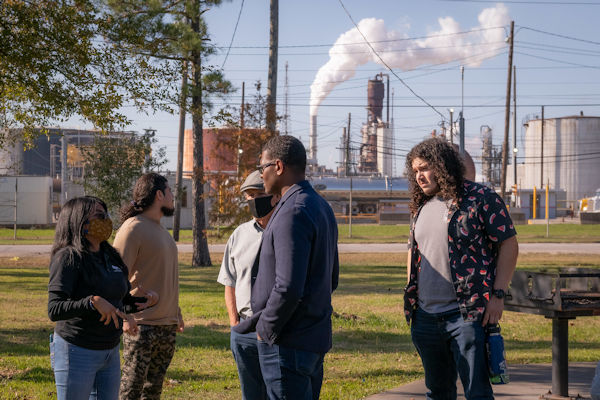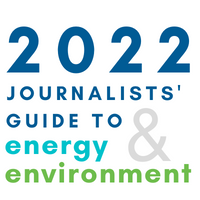SEJournal Online is the digital news magazine of the Society of Environmental Journalists. Learn more about SEJournal Online, including submission, subscription and advertising information.
 |
| EPA Administrator Michael Regan, above, second from right, during a Nov. 19, 2021 visit to Houston to meet with community members to discuss pollution and environmental justice. Photo: EPA/Eric Vance, Flickr Creative Commons. Click to enlarge. |
Issues Backgrounder: Biden Administration To Struggle With Environmental Justice in 2022
EDITOR'S NOTE: This story is one in a series of special reports from SEJournal that looks ahead to key issues in the coming year. Visit the full “2022 Journalists’ Guide to Energy & Environment” special report for more.
 |
Analysis by Joseph A. Davis
News media will be covering more environmental justice stories in 2022 — it’s a growth trend Backgrounder has been seeing for several years, and journalists have good reason to believe it will continue.
President Joe Biden, EPA Administrator Michael Regan and Interior Secretary Deb Haaland have all declared that they will make environmental justice a priority.
Will they succeed? That’s less clear.
More environmental justice coverage
could be good for a lot of marginalized
people. … It would also be good
for environmental journalism.
In either case, more environmental justice coverage could be good for a lot of marginalized people in the United States. Even the telling of their stories may help bring them farther from systemic mistreatment and closer to a fair shake.
It would also be good for environmental journalism. Reporters will be telling the stories of people who for too long have lacked voices.
A long-standing struggle
Outrage can drive good stories. A little journalistic humility can help, too. That starts with an appreciation of how long the struggle has been going on.
Just how long has environmental justice (or environmental injustice or environmental racism) festered in the United States?
The U.S. Environmental Protection Agency has a timeline that can help. As good as it is, it does not go back quite far enough — it should be at least as far as the enslavement of Africans and the colonization of Native American land.
That long history aside, you can argue the “modern” history of the environmental justice movement started with the civil rights movement of the 1960s. Or with the 1965-70 United Farm Workers strike against poor working conditions, which included exposure to pesticides. Or with Rev. Martin Luther King Jr. inspiring the strike by Memphis sanitation workers in 1968.
You could also date it from the systematic study of the underpinnings of ecoracism in the 1980s by Dr. Bob Bullard, who came to be called the “father of environmental justice.” Or with the establishment by the EPA of its National Environmental Justice Advisory Council in 1993, during the presidency of Bill Clinton.
Prospects under Biden
The ups and downs of the environmental justice struggle have partly followed the back-and-forth of power in the White House, Congress and the states. President Clinton, for instance, had issued an executive order on environmental justice back in 1994, but not much really came of it.
Joe Biden now appears to have taken up the mantle. Environmental justice was a key plank in his campaign for the White House and then part of his Jan. 27 executive order on climate once in office. He also exemplified it in his nominations of Regan, who is Black, to lead EPA and of Haaland, who is a member of the Laguna Pueblo, to head the Interior Department.
In July 2021, the White House also issued an all-hands “guidance” on its Justice40 initiative, ordering most agencies to work for environmental justice by delivering at least 40 percent of the overall benefits from federal investments in climate and clean energy to disadvantaged communities.
The Biden administration has
at least raised high expectations
for environmental justice.
So the Biden administration has at least raised high expectations for environmental justice. The story of its fulfillment (or lack thereof) is what environmental journalists will be writing about in 2022 and beyond.
Here are a few additional promising early signs:
- Biden created the White House Environmental Justice Advisory Council and the White House Environmental Justice Interagency Council, both meant to focus action and messaging from the whole federal government on environmental justice.
- Biden revoked the cross-border permit of the Keystone XL pipeline, a project that had been opposed by Indigenous communities, as well as by other environmentalists.
- The Biden U.S. Forest Service temporarily stopped a land swap that would have allowed mining at Arizona’s Oak Flat natural area, sacred to some tribal nations.
- In October 2021, Biden restored three National Monuments (may require subscription) in the Southwest and off the Atlantic Coast that had been chopped up by Trump, and which included many lands sacred to tribal nations.
- The Biden Army Corps of Engineers required a new environmental study of the proposed $8 billion Formosa Plastics plant in Louisiana, which had been opposed by various environmental justice communities.
- In November 2021, the administration declared a 20-year ban on oil and gas drilling around the Chaco Culture National Historical Park in New Mexico, an area of importance to local tribes.
- Biden’s Justice40 initiative gained new teeth with enactment of the so-called “bipartisan infrastructure bill” (HR 3684). That measure makes available roughly $1 trillion for projects, many of which could help various disadvantaged groups — including rural and urban poor people lacking broadband internet. Still hanging is the outcome of the “Build Back Better” bill, which will make available further billions that could help those groups even more.
Issues remain unaddressed, unresolved
Yet for all that, many central environmental justice issues remained unaddressed and unresolved during the first year of the administration. The Democratic Party’s traditional distributive politics (i.e., something for almost everyone) may just not be enough.
Historically, one of the most intense environmental issues has been the location of polluting — often toxic — facilities in areas inhabited by populations made especially vulnerable by lack of political power.
Important insight into this aspect of environmental justice can be found in an Aug. 1, 2021, piece in Inside Climate News by Agya K. Aning, who explores a seminal struggle back in 1978, when “white men illegally dumped” 30,000 gallons of oil laced with polychlorinated biphenyls, or PCBs, by spraying it from a truck in the dead of night.
The spraying polluted 14 counties in North Carolina, many rural, poor and Black. The subsequent political struggle in which organized victims fought back can be seen as one of the taproots of the modern environmental justice movement.
Similar struggles continue across the United States today. In many cases, the outcomes will be determined by action from EPA, the Justice Department and the states. Many relate to actions around siting, regulatory and enforcement, nitty-gritty stuff that takes digging and persistence to cover.
Finding the stories
So the stories are there — they usually have been there for a long time — waiting for someone to cover them.
Here are some suggestions about where and how environmental journalists can find many of them.
 |
| Pioneering environmental justice researcher Bob Bullard, standing, in 2015. Photo: University of Michigan, Flickr Creative Commons. Click to enlarge. |
- Superfund sites: These hazardous waste sites often endanger neighbors because the responsible parties have ducked out, leaving them as victims.
- Solid and hazardous waste sites: Sites licensed under the Resource Conservation and Recovery Act (for both regular and hazardous waste) may have started out as troublesome dumps, sometimes sited near vulnerable communities. One exploration tool is EPA’s ECHO database.
- Brownfields: Formerly polluted sites that have been cleaned up enough for industrial use may still present environmental justice issues. There are some 450,000 of them nationwide. One way to find them is with EPA’s “Cleanups in My Community” tool.
- Areas lacking clean drinking water: While EPA and states try to ensure public water systems meet safety rules of the Safe Drinking Water Act, some communities fall through the cracks. These are often small, rural communities, often on wells or unincorporated and often lived in by poor or underprivileged people. There are thousands of Flints.
- Areas lacking sewage treatment: Yes, there are poor rural communities that lack enough sewage treatment to ensure health. Read Lyndsey Gilpin’s 2017 piece about Lowndes Co., Ala. Just a few weeks ago, the Biden Justice Dept. started an investigation.
- Toxic site mapping: There are now some good tools for mapping toxic hot spots that impact vulnerable communities (be they nursery schools, nursing homes or poor Black neighborhoods). The newest and coolest comes from ProPublica and is based on earlier EPA datasets like the Toxics Release Inventory, EJSCREEN and Risk-Screening Environmental Indicators. See more in this how-to video.
An evolution of NGOs, journalists
There are other reasons, besides Biden’s agenda, that environmental justice will be in the news more in 2022. One is that environmental groups are changing. Some of the traditional big green groups are becoming more diverse and trying to incorporate environmental justice into their campaigns.
Another is that environmental journalism itself is changing. The Society of Environmental Journalists, for example, has been trying to move in this direction for a decade or more (see the 2013 "Guide to Diversity in Environmental Reporting") — and may be succeeding to a degree.
Professional groups like the National Association of Black Journalists and the National Association of Hispanic Journalists (there are many others) have grown larger and stronger. And newer groups are sprouting. Just this year a group of climate journalists of color started a networking group, the Uproot Project.
Evidence some things are changing can be seen by looking at EPA’s press releases — they show a steady flow of significant dollar grants to communities for things like lead in drinking water or diesel emissions reduction. That is likely just the beginning of what will be awarded under new infrastructure legislation.
But it will be par for the course to hear impatient and sometimes angry claims that EPA and the Biden administration are not doing enough for enough people, nor fast enough. That pressure, too, is part of the environmental justice beat and should also be expected to grow in 2022.
Joseph A. Davis is a freelance writer/editor in Washington, D.C. who has been writing about the environment since 1976. He writes SEJournal Online's TipSheet, Reporter's Toolbox and Issue Backgrounder, and curates SEJ's weekday news headlines service EJToday and @EJTodayNews. Davis also directs SEJ's Freedom of Information Project and writes the WatchDog opinion column.
* From the weekly news magazine SEJournal Online, Vol. 6, No. 43. Content from each new issue of SEJournal Online is available to the public via the SEJournal Online main page. Subscribe to the e-newsletter here. And see past issues of the SEJournal archived here.













 Advertisement
Advertisement 



